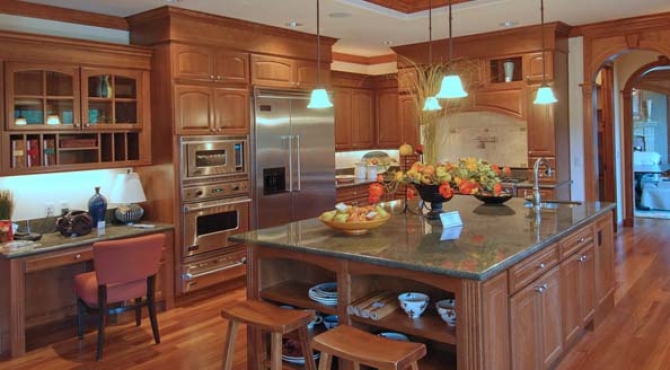Kitchens are the heart of the home and everyone uses them differently. A classic example is an experience I had when working as a young writer in New York City. My boss invited me and some co-workers to a Kentucky Derby Party at her apartment. We congregated in the kitchen to help muddle mint for the Juleps and I was struck by how immaculate the kitchen was. Come to find out, my boss never used it. She never cooked, she ate out all the time or ordered in and the only thing she kept in her refrigerator was her fur coat. The point is, that worked for her.
When designing the kitchen for your new home plan, be sure it works for you! It will be a social center where family and friends naturally congregate and not just to enjoy your cooking! Opt for open space and a natural flow into other areas of the home.
You’re designing and then building a new home which is challenging in itself. The kitchen design may be the most challenging of all. Be sure your home designer understands who you are--- what’s right for you and your lifestyle. You’ll probably spend more time in the kitchen than in any other room in the home. Listen to what the design professionals have to say but stand by your guns when it comes to your likes and dislikes. You’ll be living with it (and you’re paying for it).
I have some simple kitchen design rules I’ve developed based on personal experience.
My Rule Number 1. Don’t go overboard on the big trends of the moment, or lean too much the other way by choosing strictly traditional looks. They can become dated and boring over time. The safe alternative is to adopt a transitional approach. Transitional, as its name implies, is a blending of styles. Lines are clean but can incorporate a touch of the ornate as well. Lighting and faucets will be more on the contemporary side.
My Rule Number 2. Opt for quality. This is not a place to skimp on appliances, counter tops, cabinetry and flooring. Ask your kitchen designer to review the pros and cons of various materials available. Don’t overbuy. Consider if this is going to be your home for life or if you intend to make a move in the next few years. It’s never a good idea to go for the extremes…the most or least expensive.
My Rule Number 3. Utilize every bit of space available. In my opinion, there’s no such thing as too much counter space. Cabinet built-ins provide badly needed storage, keeping your countertops free from clutter. In my last kitchen, the drawers came with silverware dividers built in. No more of those plastic ones which never seem to fit in the drawers. I had two corner lazy Susan’s under the counters. One was for spices and canned goods, the other for small appliances.
My Rule Number 4. Be sure your major appliances are a standard size and that your counters allow enough space for standard size appliances to slide in and out easily. Recently a friend bemoaned that her old refrigerator had to be replaced and that the space it fit in was too narrow for most of today’s models. She had to special order one and wait months for it to be delivered, living out of an ice chest and an old refrigerator in her garage. The only other option was to tear her kitchen apart and remodel to accommodate a new one. Your house design professional is so important in determining dimensions and measurements and ensuring that all the parts fit seamlessly together as planned.
My Rule Number 5. Do your own research. Be sure you understand the care and upkeep of your new countertops, floors and appliances. I remodeled a kitchen in my Florida condo and selected all stainless steel appliances. They were so beautiful but they were also a magnet for fingerprints and smudges, requiring constant cleaning to look their gleaming best. Talk to your home designer and go over all the various options with them.
Rules were made to be broken so if there’s something you absolutely can’t live without, go for it. Buy that wonderful kitchen faucet that’s part stainless, part chili-pepper red. It will make a statement and create a focal point to build your décor around. Just remember, the next owner may not share your taste and anything too “unique” may be a deal breaker when it comes time to sell.
A popular extension of the home kitchen is an outdoor kitchen. As noted in an article I found on newhomesource.com, the outdoor kitchen is no longer just for warm-weather climates. People want to start entertaining outdoors earlier and stay outside longer in the season. The outdoor kitchen allows for gracious entertaining in settings that are impervious to spills and messes. This type of kitchen can be as simple or as creative as you make it. Think of your outdoor kitchen as an oasis. Adults can cook and chat; children can play within sight of parents. The experience is relaxed and informal. Work with your design professional but expect to add anywhere from $5,000 to $15,000 to the cost of your home; for those seeking some more creative and elaborate surroundings, the cost could easily reach $100,000.
Is the cost worth it? According to an article on the website Landscaping.about.com, “In a competitive economy, homeowners face the challenge of differentiating their residence from others. These spaces are a unique selling point that could act as a deciding factor amongst perspective home buyers. Also, they will last and provide enjoyment for decades. The enjoyment to be had from dining outside is passed from homeowner to homeowner. “
Make sure you sit down and really think through your new kitchen. Make a lot of notes and look online for ideas and layouts that might fit into your new house plan.
